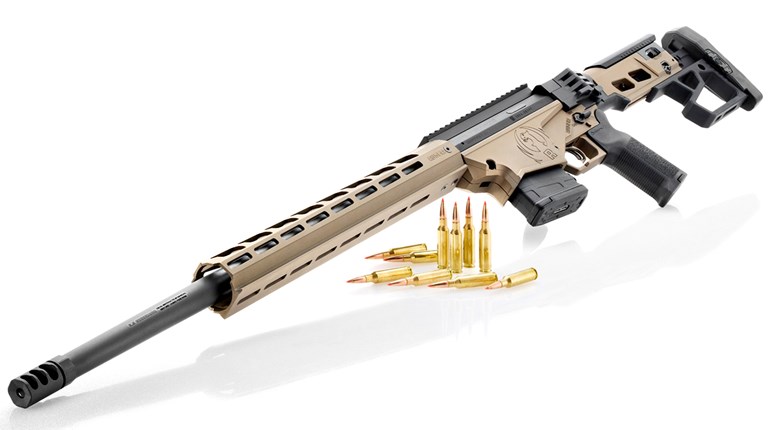
The 6.5 Creedmoor has become one of the most-popular, centerfire-rifle cartridges in America. It’s eclipsed all expectations and proved many of the naysayers wrong. Not only are 6.5 Creedmoor rifles and ammunition topping sales charts, so are handloading components for the cartridge, such as .264-caliber bullets and 6.5 Creedmoor brass. Starline Brass is now offering 6.5 Creedmoor brass with either a large- or small-primer pocket. This got me to wondering, if one had an advantage over the other.
Before we go any further, let me admit up front that I do not handload 6.5 Creedmoor ammunition. This is simply because in the vast array of factory options out there, I’ve found loads that shoot incredibly well in both of my 6.5 Creedmoor rifles. I don’t handload for fun; I handload to create ammunition delivering either precision or terminal performance I cannot buy. I just don’t have time to make ammunition I can easily get already assembled.
However, I do handload extensively for the 2Fity-HillBilly or .257 Creedmoor cartridge I wildcatted a few years back, because, well, nobody loads ammunition for it. Given that the difference in bullet diameter between the aforementioned 6.5 Creedmoor (.264) and my 2Fity-HillBilly (.257) is only .007 of an inch, I figured I could use that cartridge to evaluate the difference between small- and large-rifle primers in Starline Brass, as they might relate to the 6.5 Creedmoor.
To sort all of this out, I prepared two different loads (30 cartridges each) for the 2Fity-Hillbilly. (By the way, all you need to create 2Fity-HillBilly brass is a 6.5 Creedmoor neck-bushing die and a .277 bushing. You run the cartridge in the sizing die, load and shoot.) The first load utilized a Berger 115-grain VLD bullet ahead of 45 grains of IMR 4451 powder. Fifteen cartridges were loaded in Starline cases with Remington large-rifle primers, and 15 in Starline cases with Federal small-rifle primers. For the other load I used a Sierra 120-grain GameKing HPBT bullet ahead of 43 grains of AA 2700 powder. Again, 30 cartridges were loaded; 15 in cases with the same large-rifle primer and 15 in cases with the same small-rifle primer.
On the range, I fired three, five-shot groups with each load to establish precision, and every shot was fired over a Caldwell G2 chronograph with the screens positioned 10 feet from the muzzle. The rifle used for testing was built on a Remington 700 action with a Proof Research 1:8-inch twist barrel by Dove’s Custom Guns, here in my hometown of Princeton, WV.
For those who are statistically inclined, let me summarize the results for you. Overall, the loads with the large-rifle primers delivered a maximum velocity deviation that was 28.5 percent less than the loads utilizing the small-rifle primers and standard velocity deviation was 30.4 percent less with the large-rifle primers. As for average velocity, there was less than a 1 percent difference between the loads using the large- and small-rifle primers. The 115-grain Berger loads averaged 3,056 fps, and the 120-grain Sierra loads, 2,989 fps. Precision on target was—for all practical purposes—identical, or at least within shooter (aka my) margin of error. The two loads with the large-rifle primers averaged .855-inch for six, five-shot groups, and the two loads with small-rifle primers averaged .910 inch. What might be the takeaways from this experiment?
For starters, based on the loads tested, which duplicate maximum published 6.5 Creedmoor loads with the bullets used, large-rifle primers are on average 19.66 percent better than small-rifle primers. While this data might vary in the Creedmoor, I doubt its bore size of .007 inch larger would make much difference. Granted, in another rifle, or with a change of powder, primer, brass, bullets or even atmospheric conditions, the results could have been different. Ideally, you might want to try cases with both large- and small-primer pockets in your rifle, with your favorite loads.
Secondly, I’m convinced that Starline 6.5 Creedmoor brass is quite good stuff. In all, I fired 12, five-shot groups, and the average group size was sub MOA. In fact every group fired was less than MOA (1.047 inch.) Before every piece of brass was loaded, all necks were checked for run-out—to see how far they were off the centerline of the cartridge—and none exhibited more than a scant .002 inch of discrepancy before initial sizing.
Finally, whatever you want to call my wildcat, the 2Fity-Hillbilly or the .257 Creedmoor it is a fine cartridge capable of duplicating the performance of the .257 Roberts as well as the .250 Ackley Improved at a distance of 100 yards. Plus, cases for my wildcat do not have to be fire-formed. Though intended for hunting varmints and big game and not long-range competition, when paired with 131-grain Blackjack bullets and a 1:7 twist, it will outperform the 6.5 Creedmoor at any distance.
Until manufacturers offer the 2Fity-HillBilly with my favorite bullets, I’ll be using a lot of Starline brass. I’ll probably opt for those with large-primer pockets, but you never know. There’s always another experiment to be conducted.




































